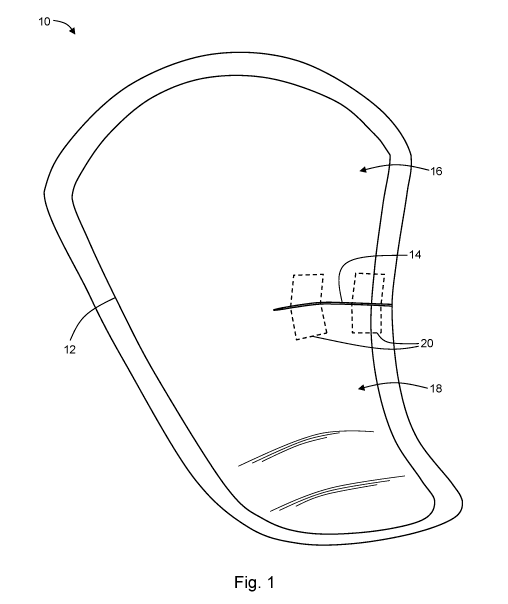Some of the information on this Web page has been provided by external sources. The Government of Canada is not responsible for the accuracy, reliability or currency of the information supplied by external sources. Users wishing to rely upon this information should consult directly with the source of the information. Content provided by external sources is not subject to official languages, privacy and accessibility requirements.
Any discrepancies in the text and image of the Claims and Abstract are due to differing posting times. Text of the Claims and Abstract are posted:
| (12) Patent Application: | (11) CA 3080344 |
|---|---|
| (54) English Title: | INCONTINENCE DEVICE |
| (54) French Title: | DISPOSITIF POUR L'INCONTINENCE |
| Status: | Examination Requested |
| (51) International Patent Classification (IPC): |
|
|---|---|
| (72) Inventors : |
|
| (73) Owners : |
|
| (71) Applicants : |
|
| (74) Agent: | MACRAE & CO. |
| (74) Associate agent: | |
| (45) Issued: | |
| (86) PCT Filing Date: | 2018-10-26 |
| (87) Open to Public Inspection: | 2019-05-02 |
| Examination requested: | 2023-10-16 |
| Availability of licence: | N/A |
| (25) Language of filing: | English |
| Patent Cooperation Treaty (PCT): | Yes |
|---|---|
| (86) PCT Filing Number: | PCT/US2018/057871 |
| (87) International Publication Number: | WO2019/084511 |
| (85) National Entry: | 2020-04-24 |
| (30) Application Priority Data: | ||||||
|---|---|---|---|---|---|---|
|
The present disclosure may be embodied as an incontinence device for a catheterized individual. The device includes an absorbent pad configured to be worn by the individual. The absorbent pad having a slit partially separating the pad into two portions. A fastener may be provided for selectively attaching the two portions to each other. In this way, a catheter may be disposed through the slit of the device and the two portions may be attached to each other using the fastener to surround a circumference of the catheter. The fastener may be reusable. In some embodiments, the device includes more than one fastener. The fastener may be one or more of an adhesive, a hook-and-loop fastener, a snap fastener, or combinations thereof.
La présente invention peut être réalisée sous la forme d'un dispositif pour l'incontinence destiné à un individu portant un cathéter. Le dispositif comprend un tampon absorbant conçu pour être porté par l'individu. Le tampon absorbant comporte une fente séparant partiellement le tampon en deux parties. Un élément de fixation peut être utilisé pour fixer de manière sélective les deux parties l'une à l'autre. De cette manière, un cathéter peut être disposé à travers la fente du dispositif et les deux parties peuvent être attachées l'une à l'autre à l'aide de l'élément de fixation pour entourer une circonférence du cathéter. L'élément de fixation peut être réutilisable. Dans certains modes de réalisation, le dispositif comprend plus d'un élément de fixation. L'élément de fixation peut être un ou plusieurs éléments parmi un adhésif, un élément de fixation à boucles et crochets, un élément de fixation à encliquetage, ou des combinaisons de ceux-ci.
Note: Claims are shown in the official language in which they were submitted.
Note: Descriptions are shown in the official language in which they were submitted.

For a clearer understanding of the status of the application/patent presented on this page, the site Disclaimer , as well as the definitions for Patent , Administrative Status , Maintenance Fee and Payment History should be consulted.
| Title | Date |
|---|---|
| Forecasted Issue Date | Unavailable |
| (86) PCT Filing Date | 2018-10-26 |
| (87) PCT Publication Date | 2019-05-02 |
| (85) National Entry | 2020-04-24 |
| Examination Requested | 2023-10-16 |
There is no abandonment history.
Last Payment of $210.51 was received on 2023-10-16
Upcoming maintenance fee amounts
| Description | Date | Amount |
|---|---|---|
| Next Payment if small entity fee | 2024-10-28 | $100.00 |
| Next Payment if standard fee | 2024-10-28 | $277.00 |
Note : If the full payment has not been received on or before the date indicated, a further fee may be required which may be one of the following
Patent fees are adjusted on the 1st of January every year. The amounts above are the current amounts if received by December 31 of the current year.
Please refer to the CIPO
Patent Fees
web page to see all current fee amounts.
| Fee Type | Anniversary Year | Due Date | Amount Paid | Paid Date |
|---|---|---|---|---|
| Application Fee | 2020-04-24 | $400.00 | 2020-04-24 | |
| Maintenance Fee - Application - New Act | 2 | 2020-10-26 | $100.00 | 2020-09-21 |
| Maintenance Fee - Application - New Act | 3 | 2021-10-26 | $100.00 | 2021-09-20 |
| Maintenance Fee - Application - New Act | 4 | 2022-10-26 | $100.00 | 2022-10-26 |
| Maintenance Fee - Application - New Act | 5 | 2023-10-26 | $210.51 | 2023-10-16 |
| Request for Examination | 2023-10-26 | $816.00 | 2023-10-16 |
Note: Records showing the ownership history in alphabetical order.
| Current Owners on Record |
|---|
| HEALTH RESEARCH, INC. |
| Past Owners on Record |
|---|
| None |